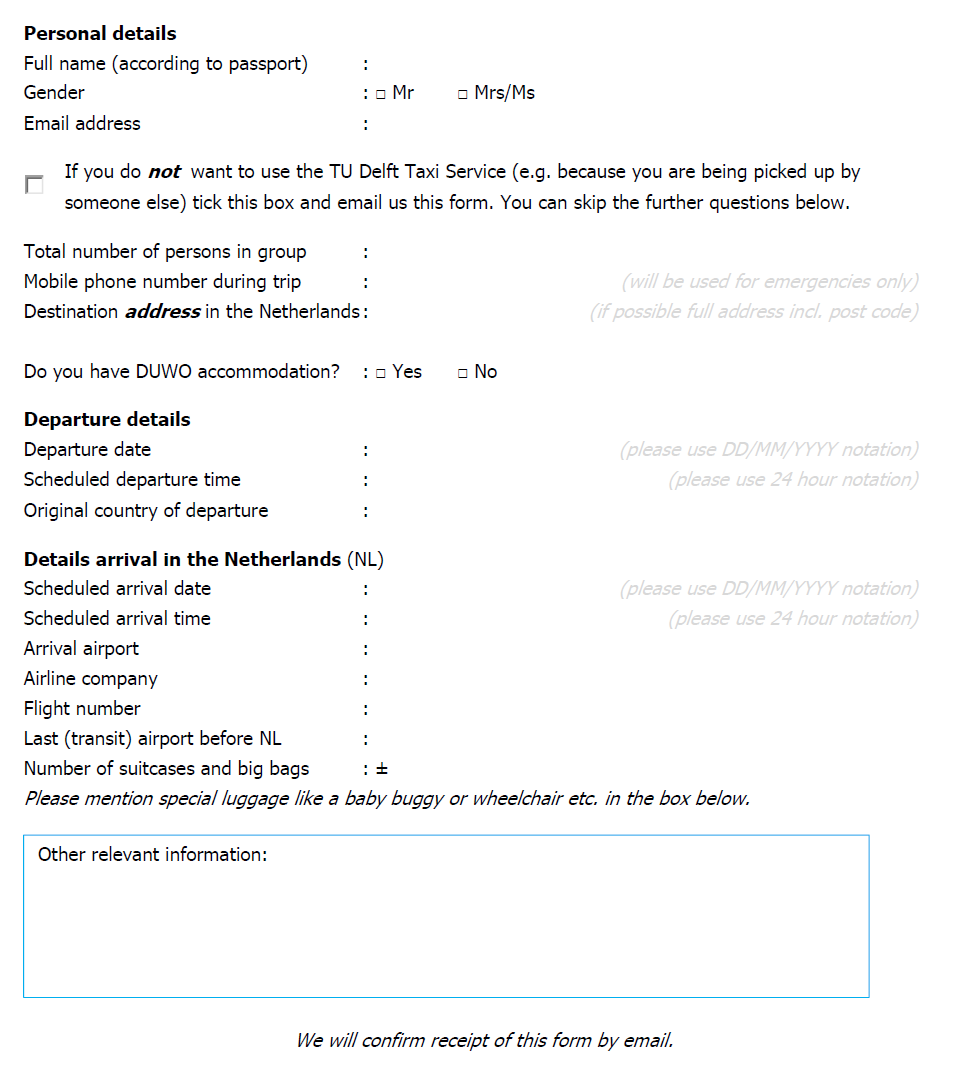Taxi Service Receipt
Save, fill-In The Blanks, Print, Done!

Download Taxi Service Receipt
Adobe Acrobat (.pdf)- This Document Has Been Certified by a Professional
- 100% customizable
- This is a digital download (216.67 kB)
- Language: English
- We recommend downloading this file onto your computer.
How to create a Taxi Service Receipt quickly? An easy way to start completing your blank receipt is to download this Taxi Receipt template now!
Creating a taxi receipt template involves designing a professional-looking receipt that includes all the necessary details of a taxi transaction. Here's a step-by-step guide to help you create your own taxi receipt template:
1) You can start with downloading this template and modify it in Word or Google Docs
You can use a word processing software like Microsoft Word or Google Docs
2. Header:
Design the header of your receipt template. This typically includes the name of your taxi company, logo (if applicable), contact information (address, phone number, website), and a unique receipt number or transaction ID.
3. Date and Time:
Include fields to capture the date and time of the taxi transaction. This helps in record-keeping and verification.
4. Passenger Information:
Add sections to record passenger details such as their name, contact number, and email address.
5. Driver Information:
Include a section for driver details, including the driver's name, taxi ID or license number, and contact information.
6. Trip Details:
Create a section to describe the trip details. This should include:
- Pick-up location
- Drop-off location
- Distance traveled
- Duration of the trip
- Fare calculation (base fare, distance-based fare, waiting time charges, etc.)
- If you have any suggestions, comments or complaints, please call Drivers Name: post code)
- Departure details
- Departure date :
- Scheduled departure time
- Original country of departure : (please use DD/MM/YYYY notation) (please use 24 hour notation)
- Details arrival
- Scheduled arrival date :
- Scheduled arrival time :
- Arrival airport :
- Airline company :
- Flight number :
- Last (transit) airport
- Number of suitcases and big bags :± (please use DD/MM/YYYY notation) (please use 24 hour notation)
- Please mention special luggage like a baby buggy or wheelchair etc..
7. Fare Breakdown:
Provide a clear breakdown of the fare. This can include:
- Base fare
- Distance charges
- Waiting time charges
- Toll charges (if applicable)
- Additional fees (if any)
8. Payment Information:
Include a section to document the payment method used (cash, credit card, etc.) and the total amount paid.
9. Terms and Conditions:
You can add a brief section outlining your company's terms and conditions, refund policy, or any other relevant information.
10. Footer:
In the footer, you can reiterate your company's contact information and encourage passengers to provide feedback.
11. Design and Branding:
Choose a clean and professional design that reflects your company's branding. Use consistent fonts, colors, and styles throughout the template.
12. Test and Refine:
Before finalizing the template, print or preview it to ensure all the information is clearly visible and well-organized. Make any necessary adjustments for readability and aesthetics.
13. Save and Distribute:
Save your receipt template in a format that's easy to share and print, such as PDF. Make sure to keep a digital copy for future use. You can then distribute the template to your drivers or passengers as needed.
Remember that regulations and requirements might differ based on your location, so ensure that your template complies with any local laws and standards for receipt documentation.
Using this document template guarantees you will save time, cost and efforts! It comes in PDF format, is ready to be tailored to your personal needs. Completing your document has never been easier!
Download this Taxi Receipt template now for your own benefit! Or have a look at this Taxi receipt in DOCX and Google Docx format.
DISCLAIMER
Nothing on this site shall be considered legal advice and no attorney-client relationship is established.
Leave a Reply. If you have any questions or remarks, feel free to post them below.
Latest templates
Latest topics
- Christmas Templates
It's Christmas... Be prepared with nice Christmas letters, invitations, social posts etc and check out these Christmas templates now! - GDPR Compliance Templates
What You Need To Be DPR compliant? Are you looking for useful GDPR document templates to make you compliant? All these compliance documents will be available to download instantly... - Google Sheets Templates
How to work with Google Sheets templates? Where to download useful Google Sheets templates? Check out our samples here. - Drop Shipping Agreement
How to start drop shipping? Do you need a Drop shipping Agreement? Check out our Dropshipping Agreement templates now! - Excel Templates
Where to find usefl Excel templates? How do I create a template in Excel? Check these editable and printable Excel Templates and download them directly!
cheese

